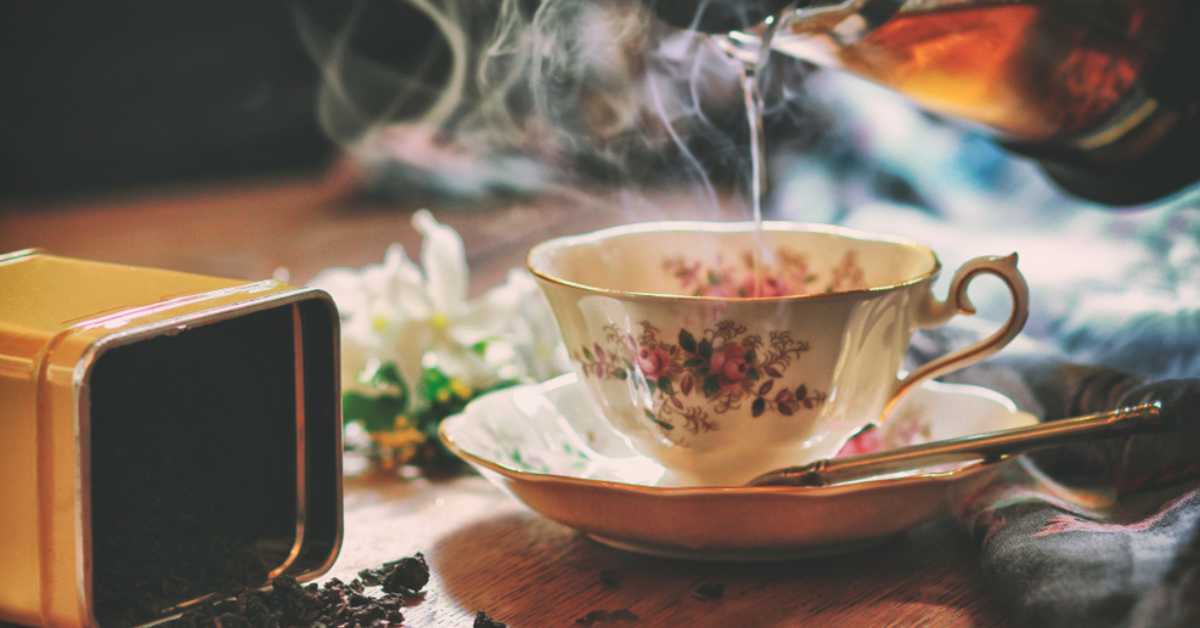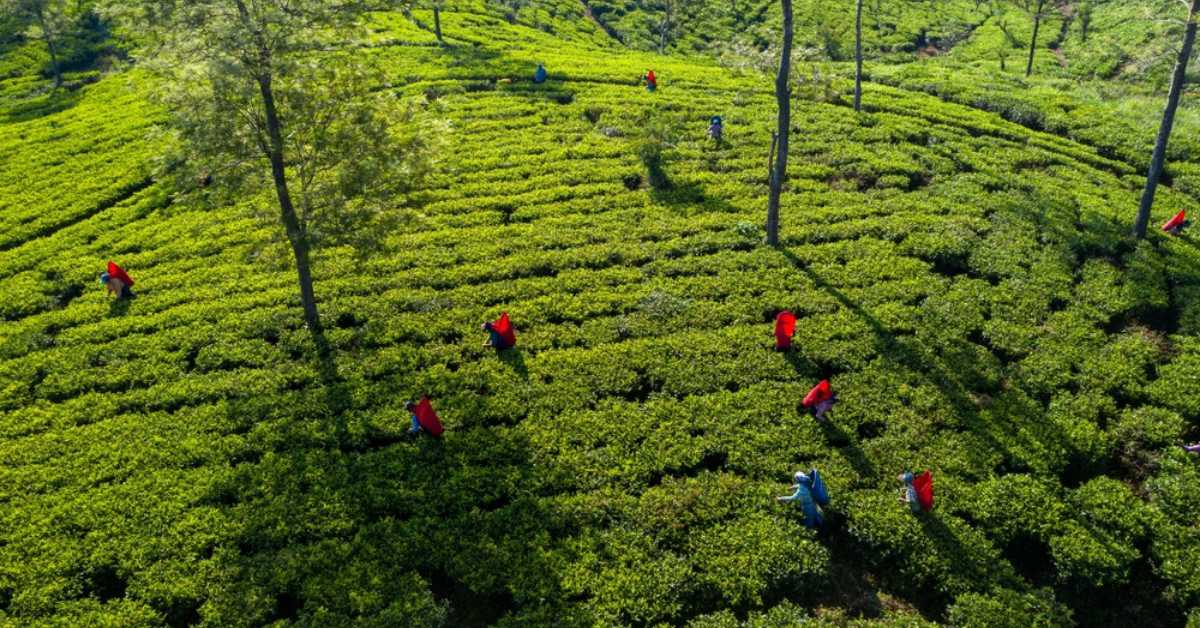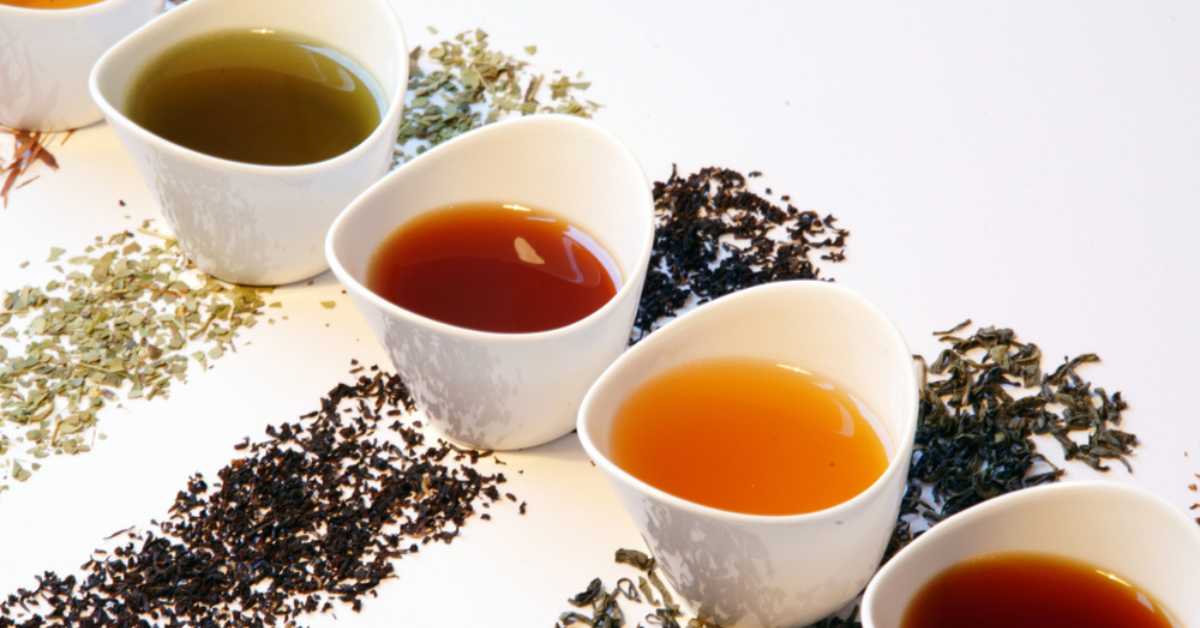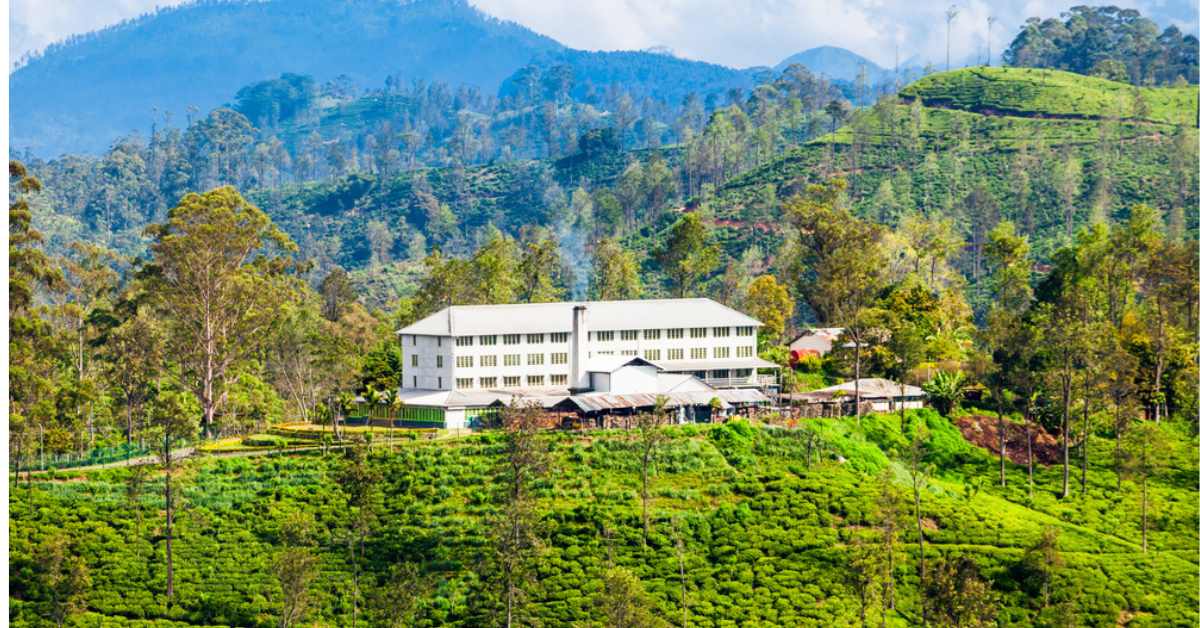
चाय दुनिया में सबसे प्रिय पेय पदार्थों में से एक है, और सीलोन चाय दुनिया की सर्वश्रेष्ठ के खिताब की शीर्ष दावेदार है। श्रीलंका में उगाई जाने वाली, जिसे पहले सीलोन के नाम से जाना जाता था, इस चाय का एक लंबा और आकर्षक इतिहास है जो 19वीं शताब्दी का है। इस लेख में, हम सीलोन चाय की उत्पत्ति का पता लगाएंगे, इसे कैसे उगाया और संसाधित किया जाता है, और इसे दुनिया की बेहतरीन चायों में से एक क्यों माना जाता है।
विषयसूची
- परिचय
- सीलोन चाय की उत्पत्ति
- श्रीलंका में चाय उद्योग
- सीलोन चाय कैसे उगाई और संसाधित की जाती है
- सीलोन चाय के प्रकार
- उत्पत्ति का महत्व (क्षेत्र)
- सीलोन चाय के स्वास्थ्य लाभ
- दुनिया भर में सीलोन चाय
- लोकप्रिय सीलोन चाय ब्रांड
- पूछे जाने वाले प्रश्न
1 परिचय
सीलोन चाय, जिसे श्रीलंकाई चाय के रूप में भी जाना जाता है, एक काली चाय है जो श्रीलंका में उगाई और उत्पादित की जाती है। अपने अनूठे स्वाद, सुगंध और रंग के कारण इसे दुनिया की सबसे अच्छी चायों में से एक माना जाता है। सीलोन चाय का इतिहास 19वीं शताब्दी का है, जब अंग्रेजों ने श्रीलंका में चाय की खेती शुरू की थी। आज, सीलोन चाय श्रीलंका के लिए एक महत्वपूर्ण निर्यात है और दुनिया भर के चाय प्रेमियों द्वारा इसका आनंद लिया जाता है।
2. सीलोन चाय की उत्पत्ति
सीलोन चाय, जिसे श्रीलंकाई चाय के रूप में भी जाना जाता है, एक प्रकार की चाय है जो विशेष रूप से श्रीलंका के द्वीप राष्ट्र में उत्पादित की जाती है। इस अनोखी चाय का एक लंबा और आकर्षक इतिहास है, जिसका इतिहास 1800 के दशक की शुरुआत में है, और यह अपने विशिष्ट स्वाद और सुगंध के लिए दुनिया भर में प्रसिद्ध है। अंग्रेजों ने सबसे पहले श्रीलंका में एक उपनिवेश स्थापित किया। यह द्वीप पहले से ही अपने कॉफी बागानों के लिए जाना जाता था, लेकिन जब 1800 के दशक के अंत में एक कवक रोग ने कॉफी उद्योग को तबाह कर दिया, तो अंग्रेजों ने प्रतिस्थापन फसल के रूप में चाय की ओर रुख किया।
1867 में, एक स्कॉटिश बागान मालिक, जेम्स टेलर ने श्रीलंका में पहली चाय की झाड़ियाँ लगाईं। द्वीप की उष्णकटिबंधीय जलवायु और समृद्ध मिट्टी में झाड़ियाँ पनपीं और जल्द ही अन्य बागान मालिकों ने भी इसका अनुसरण किया। सदी के अंत तक, श्रीलंका एक प्रमुख चाय उत्पादक देश बन गया था, जो यूरोप और अमेरिका को लाखों पाउंड चाय का निर्यात करता था।
इसके बाद के वर्षों में, देश के चाय उद्योग को बढ़ावा देने के लिए 1976 में स्थापित श्रीलंकाई चाय बोर्ड के प्रयासों के कारण, सीलोन चाय ने दुनिया भर में लोकप्रियता हासिल करना जारी रखा। आज, श्रीलंका दुनिया का चौथा सबसे बड़ा चाय उत्पादक है, और दुनिया भर में लाखों लोग सीलोन चाय का आनंद लेते हैं।
3. श्रीलंका में चाय उद्योग
श्रीलंका की अर्थव्यवस्था चाय उद्योग पर निर्भर करती है, जो लाखों लोगों को रोजगार देता है और निर्यात से बहुत सारा पैसा कमाता है। चाय देश का कपड़ा उद्योग के बाद दूसरा सबसे बड़ा निर्यात है और श्रीलंका दुनिया का चौथा सबसे बड़ा चाय उत्पादक है।
चाय बागान श्रीलंका के चाय उद्योग की रीढ़ हैं। देश में 200,000 हेक्टेयर से अधिक भूमि चाय की खेती के लिए समर्पित है, इसका अधिकांश भाग ऊंचे इलाकों में है, जहां की जलवायु उत्कृष्ट है और मिट्टी उपजाऊ है। बड़ी कंपनियां या सहकारी समितियां आम तौर पर बागानों की मालिक होती हैं, लेकिन कई छोटे पैमाने के उत्पादक अपनी चाय की पत्तियां बड़े प्रोसेसरों को बेचते हैं।
श्रीलंका की चाय दुनिया भर के 160 से अधिक देशों में निर्यात की जाती है, जिनमें सबसे महत्वपूर्ण बाजार ब्रिटेन, रूस, ईरान, ऑस्ट्रेलिया और इराक हैं। चाय दुनिया के कई हिस्सों में एक लोकप्रिय पेय है, और उच्च गुणवत्ता वाली चाय के उत्पादन के लिए श्रीलंका की प्रतिष्ठा ने इसे वैश्विक बाजार में मजबूत उपस्थिति बनाए रखने में मदद की है।
उच्च गुणवत्ता वाली, टिकाऊ रूप से उत्पादित चाय की मांग बढ़ रही है और श्रीलंका उस मांग को पूरा करने के लिए अच्छी स्थिति में है। हाल के वर्षों में, उद्योग नई चाय किस्मों, जैसे सफेद और हरी चाय, के साथ भी प्रयोग कर रहा है, जो नए बाजार और राजस्व स्रोत खोल सकती हैं। उपयुक्त निवेश और रणनीतियों के साथ, श्रीलंका में चाय उद्योग कई वर्षों तक फलता-फूलता रह सकता है।
4. सीलोन चाय कैसे उगाई और संसाधित की जाती है
सीलोन चाय को एक विशिष्ट तरीके से उगाया और संसाधित किया जाता है जो इसे अद्वितीय स्वाद और सुगंध देता है। यहां देखें कि सीलोन चाय कैसे उगाई और संसाधित की जाती है:
बढ़ती स्थितियाँ: सीलोन चाय का उत्पादन श्रीलंका के ऊंचे इलाकों में किया जाता है, जहां की जलवायु उत्कृष्ट है और मिट्टी पोषक तत्वों से भरपूर है। इस वातावरण में चाय की झाड़ियाँ पनपती हैं, जो उच्च गुणवत्ता वाली चाय बनाने के लिए आदर्श कोमल पत्तियाँ पैदा करती हैं।
पत्तियां तोड़ना: चाय की पत्तियों को आम तौर पर हाथ से तोड़ा जाता है, जिससे यह सुनिश्चित होता है कि केवल सबसे कोमल पत्तियों की ही कटाई की जाए। तोड़ाई कुशल श्रमिकों द्वारा की जाती है जो प्रसंस्करण के लिए उपयुक्त पत्तियों और कलियों का सावधानीपूर्वक चयन करते हैं।
मुरझाना: एक बार जब पत्तियाँ तोड़ ली जाती हैं, तो उन्हें बड़ी ट्रे में फैला दिया जाता है और सूखने के लिए छोड़ दिया जाता है। यह प्रक्रिया पत्तियों से अतिरिक्त नमी को हटा देती है, जिससे वे बेलने के लिए अधिक लचीली हो जाती हैं।
रोलिंग: सूखने के बाद, प्राकृतिक तेल और स्वाद यौगिकों को छोड़ने के लिए पत्तियों को लपेटा जाता है। यह ऑपरेशन के पैमाने के आधार पर, रोलिंग मशीन का उपयोग करके या हाथ से किया जाता है। बेलने से पत्तियों को वांछित आकार और आकार देने में भी मदद मिलती है।
किण्वन: फिर बेली हुई पत्तियों को थोड़े समय के लिए किण्वित होने के लिए छोड़ दिया जाता है, आमतौर पर 30 मिनट से लेकर कुछ घंटों के बीच। यह प्रक्रिया चाय के अनूठे स्वाद और सुगंध को विकसित करने में मदद करती है।
सुखाना: किण्वन के बाद, पत्तियों को बड़े ओवन में या सूरज के संपर्क में रखकर सुखाया जाता है। यह किण्वन प्रक्रिया को रोक देता है और चाय के स्वाद और सुगंध को लॉक कर देता है।
छँटाई: अंतिम चरण छँटाई है, जहाँ पत्तियों को आकार, आकार और गुणवत्ता के अनुसार वर्गीकृत किया जाता है। सबसे अच्छी पत्तियाँ उच्च-स्तरीय चाय के लिए आरक्षित होती हैं, जबकि निम्न-श्रेणी की पत्तियाँ सस्ते मिश्रणों के लिए उपयोग की जाती हैं।
5. सीलोन चाय के प्रकार
सीलोन चाय अद्वितीय स्वाद और सुगंध के साथ विभिन्न प्रकारों में आती है। यहां सीलोन चाय के कुछ सबसे लोकप्रिय प्रकारों पर करीब से नज़र डाली गई है:
काली चाय: काली चाय सीलोन चाय का सबसे आम प्रकार है, जो श्रीलंका में उत्पादित चाय का 90% से अधिक है। यह मुरझाई और किण्वित चाय की पत्तियों से बनाया जाता है, जो इसे विशिष्ट स्वाद और सुगंध देता है। सीलोन काली चाय अपने मजबूत और पूर्ण स्वाद के लिए जानी जाती है और अक्सर दूध और चीनी के साथ इसका आनंद लिया जाता है।
हरी चाय: हरी चाय काली चाय का एक लोकप्रिय विकल्प है, खासकर उन लोगों के लिए जो हल्का स्वाद और कम कैफीन सामग्री चाहते हैं। यह बिना किण्वित चाय की पत्तियों से बनाया जाता है जिन्हें भाप में उबालकर सुखाया जाता है। सीलोन ग्रीन टी में घास और फूलों के नोट्स के साथ हल्का, ताज़ा स्वाद होता है।
सफेद चाय: सफेद चाय एक दुर्लभ और महंगी चाय है जो चाय के पौधे की सबसे छोटी पत्तियों और कलियों से बनाई जाती है। पत्तियां मुरझाई हुई और सूखी होती हैं लेकिन किण्वित या लुढ़की हुई नहीं होती हैं, जो इसे पुष्प और फल के नोट्स के साथ एक नाजुक, सूक्ष्म स्वाद देती है। सीलोन सफेद चाय अपने नरम और सूक्ष्म स्वाद के लिए अत्यधिक बेशकीमती है।
ऊलोंग चाय: ओलोंग चाय आंशिक रूप से किण्वित चाय है जो स्वाद और सुगंध के मामले में काली और हरी चाय के बीच आती है। यह मुरझाई हुई पत्तियों से बनाया जाता है जिन्हें आंशिक रूप से किण्वित किया जाता है और फिर सुखाया जाता है। सीलोन ऊलोंग चाय में फूलों और अखरोट के स्वाद के साथ एक जटिल, बहुस्तरीय स्वाद होता है।
स्वादयुक्त चाय: फ्लेवर्ड चाय सीलोन चाय का आनंद लेने का एक लोकप्रिय तरीका है, क्योंकि इसमें फल, फूल और मसालों जैसे विभिन्न प्राकृतिक स्वादों का मिश्रण किया जा सकता है। फ्लेवर्ड सीलोन चाय विभिन्न मिश्रणों में आती है, जिसमें अर्ल ग्रे, मसाला चाय और वेनिला शामिल हैं।
प्रत्येक प्रकार की सीलोन चाय का अपना अनूठा स्वाद और सुगंध होती है, जिससे आपकी स्वाद प्राथमिकताओं के अनुरूप चाय ढूंढना आसान हो जाता है। चाहे आप ठोस और भरपूर काली चाय पसंद करते हों या नाजुक और सूक्ष्म सफेद चाय, सीलोन चाय में हर चाय प्रेमी के लिए कुछ न कुछ है।
6. उत्पत्ति (क्षेत्र) का महत्व
चाय उत्पादन पर विभिन्न जलवायु के प्रभाव की खोज से श्रीलंका में प्रत्येक कृषि-जलवायु क्षेत्र के लिए अद्वितीय गुणवत्ता वाली चाय की विविधता का निर्माण हुआ है। यह पृथ्वी पर कहीं और नहीं पाया जा सकता। नुवारा एलिया, हाइलैंड क्षेत्र में डिंबुला, उवा, और उदा पुसल्लावा, कैंडी मध्य देश में, और श्रीलंका के निचले देश क्षेत्र में रूहुना और संबलगामुवा अपनी चाय के लिए अंतरराष्ट्रीय स्तर पर प्रसिद्ध हैं।
नुवारा एलिया: श्रीलंका में सबसे प्रसिद्ध चाय उगाने वाला क्षेत्र, सबसे पहाड़ी है और इसकी औसत ऊँचाई सबसे ज़्यादा है। कम तापमान के साथ, यह एक असाधारण सुगंध वाली चाय पैदा करता है। कप में जलसेक सभी सीलोन चाय किस्मों में सबसे हल्का होता है, जिसमें सुनहरा रंग और नाजुक सुगंधित स्वाद होता है। पूरे पत्ते वाला ऑरेंज पेको (ओपी) और ब्रोकन ऑरेंज पेको (बीओपी) इस क्षेत्र की सबसे पसंदीदा चाय किस्में हैं।
डिंबुला: नुवारा एलिया और हॉर्टन प्लेन्स के बीच डिंबुला जिला है, जिसकी चाय को "उच्च उगाई गई" के रूप में परिभाषित किया गया है क्योंकि सभी एस्टेट 1,250 मीटर (4000 फीट) की ऊंचाई से अधिक हैं। क्षेत्र की जटिल स्थलाकृति विभिन्न सूक्ष्म जलवायु पैदा करती है, जिनके स्वाद में अंतर होता है - कभी-कभी चमेली के साथ सरू का मिश्रण होता है। हालाँकि, सभी में डिंबुला चरित्र साझा है: एक चाय जो कप में एक नाजुक सुनहरा-नारंगी रंग बनाती है और जो ताज़ा रूप से मधुर होती है।
उवा: दूर स्थित उवा क्षेत्र उत्तर-पूर्व और दक्षिण-पश्चिम मानसूनी हवाओं के संपर्क में है, जिसके बारे में माना जाता है कि यहाँ उगाई जाने वाली चाय को एक अद्वितीय, विशिष्ट व्यक्तित्व और विदेशी सुगंधित स्वाद प्रदान करता है। विक्टोरियन उद्यमी थॉमस लिप्टन ने अपने उवा बागानों में उगाई गई चाय का उपयोग करके अमेरिकियों को चाय पीने के लिए राजी किया। एक बार सामने आने पर, उवा चाय का मधुर, चिकना स्वाद तुरंत पहचाना जा सकता है।
उदा पुसेलवा: जबकि उदा पुसेलावा नुवारा एलिया के निकट है, इसकी चाय की तुलना अक्सर इसके पड़ोसी से की जाती है। इसके विपरीत, यह कप में गहरे रंग की, लाल रंग की, अधिक शक्तिशाली और आश्चर्यजनक रूप से तीखी होती है। माना जाता है कि, वर्ष के अंत में ठंडी परिस्थितियाँ मध्यम शरीर और नाजुक स्वाद वाली चाय की सुगंध में गुलाब का एक निशान प्रदान करती हैं। फिर भी, भारी वर्षा से स्वाद में और भी गहरे और अधिक मजबूत चाय मिलती है।
कैंडी: कैंडी क्षेत्र में उत्पादित चाय, जहाँ उद्योग की शुरुआत 1867 में हुई थी, को "मध्यम विकसित" के रूप में जाना जाता है क्योंकि खेती 1,300 मीटर से अधिक नहीं होती है। स्वाद ऊंचाई के आधार पर भिन्न होता है और बागान मानसूनी हवाओं से सुरक्षित है या नहीं। वे स्वादिष्ट हैं। कैंडी चाय का आसव तांबे के रंग के साथ शानदार है, और वे मजबूत और शक्तिशाली रूप से पूर्ण शरीर वाले हैं।
रूहुना: रूहुना क्षेत्र की चाय को "कम विकसित" माना जाता है क्योंकि वे तटीय मैदानों से लेकर दक्षिणी सीमा तक के व्यापक उपक्षेत्रों में 600 मीटर से कम की ऊंचाई पर पैदा होती हैं। सिंहराजा वर्षा वन. मिट्टी, एस्टेट की कम ऊंचाई के साथ मिलकर, चाय की झाड़ी के तेजी से विकास को बढ़ावा देती है, जिसके परिणामस्वरूप लंबी, आकर्षक पत्तियां पैदा होती हैं। पूर्ण स्वाद वाली काली चाय की खासियत रूहुना है। रूहुना की पत्तियाँ बनाने वाली सुविधाएँ वांछित "टिप्स" सहित विभिन्न प्रकार की पत्तियाँ और आकार उत्पन्न करती हैं।
सबारागामुवा: सबारागामुवा श्रीलंका का सबसे बड़ा जिला है और इसके चाय बागान समुद्र तल से 610 मीटर की ऊंचाई तक फैले हुए हैं। सबारागामुवा दक्षिण में सिंहराजा और दक्षिण में तेनकासी के बीच स्थित है। एडम की चोटी उत्तर में जंगल, एक बड़ी पत्ती वाली झाड़ी पैदा करता है जो कई गुना बढ़ती है। यह पेय रूहुना चाय से भी तुलनीय है; यह गहरे पीले-भूरे रंग का है जिसमें लाल रंग का आभास है। हालाँकि, इसकी खुशबू रूहुना के सामान से काफी अलग है, जिसमें मीठे कारमेल का एक स्पर्श है जो उतना मजबूत नहीं है लेकिन फिर भी उत्कृष्ट रूप से परिष्कृत है।
7. सीलोन चाय के स्वास्थ्य लाभ
अपने स्वादिष्ट स्वाद और सुगंध के अलावा, सीलोन चाय स्वास्थ्य लाभों से भी भरपूर है। यहां कुछ तरीके दिए गए हैं जिनसे सीलोन चाय पीने से आपके स्वास्थ्य को लाभ हो सकता है:
प्रतिरक्षा प्रणाली को बढ़ावा देता है: सीलोन चाय एंटीऑक्सीडेंट से भरपूर होती है, जो प्रतिरक्षा प्रणाली को बढ़ावा देने और शरीर को बीमारी से बचाने में मदद करती है। एंटीऑक्सिडेंट मुक्त कणों से लड़ने में भी मदद करते हैं, जो कोशिकाओं को नुकसान पहुंचा सकते हैं और उम्र बढ़ने और बीमारी में योगदान कर सकते हैं।
हृदय स्वास्थ्य को बढ़ावा देता है: रक्तचाप को कम करने और कोलेस्ट्रॉल के स्तर में सुधार करने की क्षमता के कारण सीलोन चाय को हृदय रोग के जोखिम को कम करने से जोड़ा गया है। इसके अलावा, सीलोन चाय में फ्लेवोनोइड्स नामक यौगिक होते हैं, जो रक्त प्रवाह को बेहतर बनाने और शरीर में सूजन को कम करने में मदद करते हैं।
पाचन स्वास्थ्य का समर्थन करता है: सीलोन चाय में टैनिन होता है, जो प्राकृतिक यौगिक हैं जो पाचन तंत्र को शांत करने और सूजन को कम करने में मदद करते हैं। परिणामस्वरूप, सीलोन चाय सूजन, कब्ज और दस्त जैसी पाचन समस्याओं को कम करने में मदद कर सकती है।
मानसिक सतर्कता बढ़ाता है: सीलोन चाय में कैफीन होता है, जो मानसिक सतर्कता बढ़ाने और फोकस में सुधार करने में मदद कर सकता है। हालाँकि, सीलोन चाय में कॉफी की तुलना में कैफीन की मात्रा कम होती है, जो इसे कम कैफीन बढ़ाने की तलाश करने वालों के लिए एक उत्कृष्ट विकल्प बनाती है।
वजन घटाने को बढ़ावा देता है: सीलोन चाय पीने से चयापचय को बढ़ावा देने और वजन घटाने को बढ़ावा देने में मदद मिल सकती है। सीलोन चाय में कैटेचिन नामक यौगिक होते हैं, जो शरीर को वसा जलाने और वजन कम करने में मदद करते हैं।
मौखिक स्वास्थ्य को बढ़ावा देता है: सीलोन चाय में फ्लोराइड होता है, जो दांतों के इनेमल को मजबूत करने और कैविटी को रोकने में मदद कर सकता है। सीलोन चाय पीने से आपकी सांसों को ताज़ा करने और मुंह में हानिकारक बैक्टीरिया की वृद्धि को कम करने में भी मदद मिल सकती है।
सीलोन चाय एक स्वादिष्ट और स्वास्थ्यवर्धक पेय है जो कई प्रकार के स्वास्थ्य लाभ प्रदान करती है। चाहे आप अपनी प्रतिरक्षा प्रणाली को बढ़ावा देना चाहते हों, हृदय स्वास्थ्य को बढ़ावा देना चाहते हों, या मानसिक सतर्कता में सुधार करना चाहते हों, सीलोन चाय एक स्वस्थ और ताज़ा पेय के लिए एक उत्कृष्ट विकल्प है।
8. दुनिया भर में सीलोन चाय
श्रीलंका सबसे बड़ा उत्पादक देश है जो अपनी चाय का निर्यात करने से पहले उसका मूल्य जोड़ता है। कई चाय के पैकेट और बैग सालाना भेजे जाते हैं, जो कुल मात्रा का लगभग 40% और कुल आय का 45% होता है। बॉक्सबोर्ड कार्टन, फ़ॉइल पैक, नरम लकड़ी के बक्से, धातु के डिब्बे, सिरेमिक जार और लकड़ी के बक्से सभी का उपयोग सीलोन चाय के निर्यात के लिए किया जाता है।
आजकल, सीलोन चाय लगभग 160 देशों में निर्यात की जाती है। मध्य पूर्व, खाड़ी और उत्तरी अफ्रीका क्षेत्र श्रीलंका के पचास प्रतिशत से अधिक निर्यात को अवशोषित करता है। रूसी संघ और सीआईएस देश सीलोन चाय के लिए दूसरा सबसे महत्वपूर्ण बाजार बने हुए हैं, जो कुल निर्यात का लगभग 20% है।
सुदूर पूर्व सीलोन चाय के लिए एक महत्वपूर्ण बाज़ार बनता जा रहा है। सबसे आशाजनक नए बाजार की पहचान चीन के रूप में की गई है, जो सालाना 10 मिलियन किलोग्राम से अधिक सीलोन काली चाय का आयात करता है और खरीदार की सूची में सातवें स्थान पर है। जापान सुदूर पूर्व के क्षेत्र में सीलोन चाय का दूसरा ऐतिहासिक आयातक है। सबसे हालिया प्रवृत्ति पश्चिम अफ्रीका में श्रीलंकाई चाय बैग की मांग में क्रमिक वृद्धि है।
श्रीलंका के चाय उद्योग प्रतिभागियों के बीच स्थिरता एक ट्रेंडी शब्द नहीं है। हालाँकि, हाल के वर्षों में, सीलोन चाय की खेती, विनिर्माण, भंडारण, परिवहन और वितरण के सभी पहलुओं में टिकाऊ प्रथाओं पर जोर दिया गया है क्योंकि नए कानून और उद्योग मानक लागू किए गए हैं।
9. लोकप्रिय सीलोन चाय ब्रांड
कई प्रसिद्ध सीलोन चाय ब्रांड श्रीलंका और दुनिया भर में व्यापक रूप से उपलब्ध हैं। यहां कुछ सबसे प्रसिद्ध ब्रांड हैं:
दिलमाः 1988 में मेरिल जे. फर्नांडो द्वारा स्थापित, दिलमाह श्रीलंका के सबसे मशहूर चाय ब्रैंड में से एक है। कंपनी अपनी गुणवत्ता और स्थिरता के प्रति प्रतिबद्धता के लिए जानी जाती है और इसकी चाय 100 से ज़्यादा देशों में उपलब्ध है।
अकबर चाय: श्रीलंका में स्थित, अकबर चाय एक पारिवारिक स्वामित्व वाली कंपनी है जो 1972 से उच्च गुणवत्ता वाली सीलोन चाय का उत्पादन कर रही है। कंपनी कई प्रकार की चाय पेश करती है, जिनमें काली, हरी और सुगंधित किस्में शामिल हैं।
तुलसीर चाय: बेसिलूर श्रीलंका का एक ब्रांड है जो अपने अनोखे मिश्रणों और पैकेजिंग के लिए जाना जाता है। कंपनी कई तरह की चाय उपलब्ध कराती है, जिसमें काली, हरी, सफ़ेद और हर्बल मिश्रण शामिल हैं।
मेलस्ना चाय: यह एक प्रीमियम चाय ब्रांड है जो उच्च गुणवत्ता वाली सीलोन चाय बनाने में माहिर है। यह कंपनी श्रीलंका में स्थित है, और मेलस्ना स्वादिष्ट और टिकाऊ चाय बनाने के लिए 2003 में स्थापित किया गया था।
10. सीलोन चाय के बारे में अक्सर पूछे जाने वाले प्रश्न
सीलोन चाय के बारे में अक्सर पूछे जाने वाले कुछ प्रश्न यहां दिए गए हैं:
1. सीलोन चाय बनाने का सबसे अच्छा तरीका क्या है?
सीलोन चाय बनाने का सबसे अच्छा तरीका व्यक्तिगत पसंद पर निर्भर करता है। आम तौर पर, सीलोन चाय को उस पानी से बनाया जाना चाहिए जिसमें अभी उबाल आया हो और 3-5 मिनट तक भिगोया हुआ हो। हालाँकि, कुछ लोग मजबूत या कमजोर शराब पसंद करते हैं, इसलिए आपके लिए सही शराब बनाने की विधि खोजने के लिए प्रयोग करना महत्वपूर्ण है।
2. क्या सीलोन चाय में कैफीन की मात्रा अधिक होती है?
सीलोन चाय में कैफीन होता है, लेकिन इसकी मात्रा चाय के प्रकार और इसे बनाने के तरीके के आधार पर भिन्न हो सकती है। आम तौर पर, सीलोन चाय जैसी काली चाय में हरी या सफेद चाय की तुलना में अधिक कैफीन होता है।
3. क्या सीलोन चाय का सेवन दूध और चीनी के साथ किया जा सकता है?
हां, सीलोन चाय का सेवन दूध और चीनी के साथ किया जा सकता है। यूनाइटेड किंगडम और भारत सहित कई देशों में सीलोन चाय का आनंद लेने का यह एक आम तरीका है।
4. सीलोन चाय पीने के स्वास्थ्य लाभ क्या हैं?
सीलोन चाय एंटीऑक्सीडेंट का एक समृद्ध स्रोत है और इसके कई स्वास्थ्य लाभ हैं, जिनमें हृदय स्वास्थ्य में सुधार, बेहतर पाचन और कुछ प्रकार के कैंसर का खतरा कम होना शामिल है।
5. क्या सीलोन चाय एक टिकाऊ फसल है?
श्रीलंका में चाय उद्योग ने सीलोन चाय को अधिक टिकाऊ फसल बनाने के लिए महत्वपूर्ण प्रयास किए हैं। कई चाय बागान पर्यावरण-अनुकूल कृषि पद्धतियों का उपयोग करते हैं और प्राकृतिक पर्यावरण की रक्षा के लिए काम करते हैं। इसके अतिरिक्त, उद्योग ने यह सुनिश्चित करने के लिए निष्पक्ष श्रम प्रथाओं को लागू किया है कि श्रमिकों के साथ उचित व्यवहार किया जाए।
सीलोन चाय एक स्वादिष्ट और बहुमुखी पेय है जिसका आनंद कई तरीकों से लिया जा सकता है। चाहे आप गर्म या बर्फीली, दूध के साथ या बिना, सीलोन चाय एकदम सही है। अपने समृद्ध इतिहास और कई स्वास्थ्य लाभों के साथ, सीलोन चाय एक ऐसा पेय है जो प्रसन्न और ताज़ा करेगा।
लेख द्वारा
रविन्दु दिलशान इलंगकून
श्रीलंका ट्रैवल पेजेस के सह-संस्थापक और कंटेंट प्रमुख के रूप में, मैं यह सुनिश्चित करता हूं कि हमारे द्वारा प्रकाशित प्रत्येक ब्लॉग पोस्ट अद्भुत हो।






